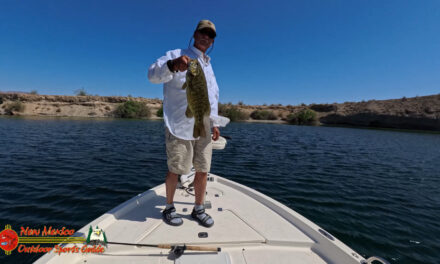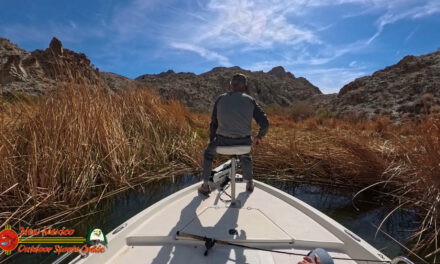Pond & Creek Bass Fishing – Lake Mohave
Fishing small back waters, ponds, tanks and creeks can be lots of fun and exciting entertainment. If you are like most anglers, it doesn’t matter where you fish, just so long as there is enough water to dangle a hook, line and bait in, with the hopes of enticing a fish to bite! One of our favorite pastimes when we go to visit my parents in South Texas is to get dad, John Barnes, and go over to the pond or the creek and spend a few quality hours probing the waters for the ever elusive black bass.
When preparing for a fishing trip, no matter how big or how small, your success often depends on how well you have planned. After years of fishing ponds and creeks with dad, it becomes routinely habit to gather certain items to throw into the tackle box for the trip. Some of those items include: needle nose pliers, assorted hooks, weights and soft plastic baits, small spinnerbaits, scissors, sun screen, bug spray, bottled water and of course, my Skeeter hat.
As pond and creek bass are pretty selective, colors for soft plastics are fairly simple. The water is stained, so they seem to consistently want small baits in neutral colors with some form of pumpkinseed as the primary color. They may vary as to preference for the day being either green, blue, or red flake mixed in with the pumpkinseed. We’ve tried other colors, but they always bite better on pumpkinseed. I’ve fished other ponds with dark, clear water and the primary colors are usually darker such as black, blue, watermelon, red shad, etc.
When selecting bait size for small water fishing, it has been my experience that pond and creek bass want smaller baits than we use on the big man-made reservoirs. To accommodate them, I usually select centipedes, small Zoom Trick worms, 4″ ring worms, or 4-5″ lizards (all plastic). The only time we use live bait is when we’re working a kids fishing tournament.
After gathering an assortment of soft plastics, I also throw in some small spinnerbaits.
Mr. Blitz makes a spinnerbait called the Clown which is great for pond fishing as well as the bigger reservoirs. Norman and I have caught really big bass on this bait no matter what lake we’re fishing. Excalibur and Strike King also make a good bait in the 1/8 to 1/4 oz. size, as well as the old H&H spinnerbait, which works really good with a yellow or chartreuse/yellow skirt. The H&H will usually catch more fish, but they are generally smaller in size. A Beetle Spin is a hard bait to beat on these kinds of waters, especially in the yellow/orange color, primarily because it looks like a natural food in small waters.
In addition to downsizing baits, you also have to downsize line and equipment. We prefer to use spinning gear so that we can cast under and around the bushes and throw at angles rather than straight overhead casts typical of traditional baitcasting equipment. Most ponds and creeks have quite a bit of underbrush, weeds, overhanging trees, bushes, etc. as obstacles for the angler to get either the rod tip or line tangled in. We prefer to use 8-10 pound test line in Bagley Silver Thread, Berkley Big Game or Stren lines.
Once you’ve gathered all the equipment, how do you rig it for the most productive way to fish these kinds of waters? A lot of it is trial and error. You keep trying different methods until you find something that works. On our particular pond, a favorite way to rig is with the mini Carolina rig. Cut off about 12-14″ of line to be used as a leader. Tie a small barrel swivel to the line on the end connected to the rod, and attach one end of the leader to the swivel, to the other end of the leader, tie on a Gamakatsu 2/0 wide gap flippin hook or a size 1/0 wide gap hook. Depending on the wind conditions, you may or may not want to experiment using a split shot (you need enough weight to get the bait to go down, but not so much weight that it mires down in the muck on the bottom). If you do need to use additional weight to get the bait to sink, place the split shot on the line about ½-inch above the hook; or if you want the bait to float up more to attract suspended fish, place the splitshot just above the swivel. Next rig up your plastic worm, Texas style, and your in business. When rigging a centipede, we like to use the Owner 1/0 riggin hook or a 1/0 light wire hook tied to our leader. Because the hook is so light, it lets the centipede float up off the bottom and tends to trigger more aggressive strikes.
Depending on the time of year and the conditions, you’re likely to find the fish in different places. In the spring, look for them on the shallow end of the pond, usually around some type of cover such as laydowns, submerged trees, logjams, buckbrush, bushes, etc. Always make a point of fishing where the cover is on the pond or creek. Other good areas are points, either on the sides or in front of the point. Also, cuts and drains that run into the pond, etc. are always likely places. Always spend a little extra time in these areas as you’re very likely to get bit! In the heat of the summer, the bass are more likely to be suspended in the deeper water, although this is not always the case. Just like on the bigger reservoirs, during the summer the fish are likely to be more aggressive in the early hours of the day and again later in the evening. But most other times of the year the fish are slow to rise and get going, so it’s not critical to be on the pond at the crack of daylight!
While visiting my folks last weekend, a friend of dad’s, Raffael Garcia, went with us to the pond. Raffael had never been bass fishing, but he caught the first bass of the day on a small pumpkinseed with blue flake Zoom Trick worm. Dad caught the most; and, he caught them all on an H&H spinnerbait. Almost every cast he caught a bass or had one knock the blades of the spinnerbait as it was being reeled back to the bank. I caught the biggest bass on a Zoom Pumpkinseed red flake Trick worm, with the fish going about 4-pounds or so. We fished from a little after 7:00 a.m. until around 9:00 a.m. and dad must have caught at least a dozen or more bass on his H&H spinnerbait with the yellow skirt. We fished until the mosquitoes started carrying us off and the air just got to hot and too still. It was time to head back to the house for some of mom’s wonderful biscuits with homemade dewberry jam, bacon and eggs. What a way to top off a great morning of fishing! Dad couldn’t recall when he had caught so many bass in such a short period of time, but it tickled me to watch him reel fish after fish in and holler for me to get the camera to take a quick photo before we would gently release the fish back into the pond so it could be caught another day.
Remember, not everyone starts out with a fancy rig like our Boots Follmar Marine Pro Staff Skeeter with a big Yamaha 225 EFI engine. We’ve each spent over twenty years in this sport competitively fishing and have gradually worked our way into the bigger and finer boats. You don’t have to be rich to fish, but you do have to have patience and a strong desire to succeed and be willing to work at improving skills, techniques and performance.
It’s always more fun to take along someone new to fishing and to share the experience and the fun. Introduce them to a sport that will likely stay with them a lifetime. Fishing is a great experience and the love of the sport should be passed on from generation to generation. Till next time, no matter where you’re fishing, have fun, take pictures for the memories; and remember to practice catch and release. It just doesn’t get any better than this, not even on the big waters! – Lake Mohave
Read More




